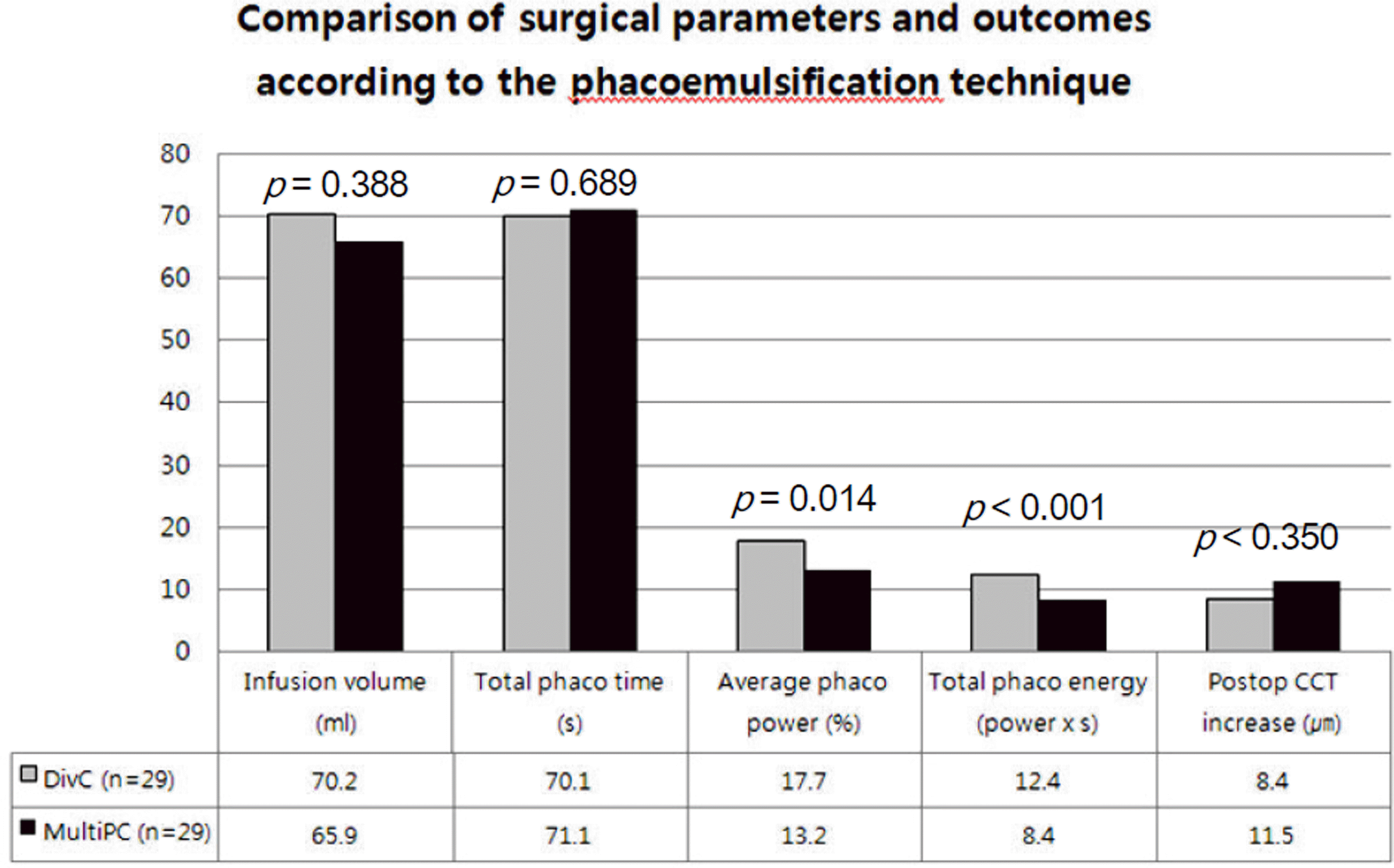Abstract
Purpose
To compare intraoperative parameters and postoperative results between divide-and-conquer and multiple pha-co-chop technique.
Methods
Two different techniques were performed by one operator on the patients with bilateral cataract. One eye was phacoemulsified by divide-and-conquer technique (D eye), and the other was performed by multiple phaco-chop technique (M eye). Changes of central corneal thickness during the operation, total phaco-time and phaco-energy were measured.
Results
Total 29 patients were included. The change of central corneal thickness were 8.4 ± 11.8 μ m in D eye and 11.5 ± 16.7 μ m in M eye, which showed no significant difference (p = 0.350) and total phaco-time were 70.1 ± 32.9 seconds in D eye and 71.1 ± 55.0 seconds in M eye, which also showed no significant difference (p = 0.689). However, phaco-energy were 12.4 ± 8.3 power × s in D eye and 8.4 ± 9.9 power × s in M eye, and this result showed significantly larger energy when using divide-and-conquer technique (p < 0.001).
Conclusions
There was no significant difference in change of central corneal thickness and phaco-time between two techniques, divide-and-conquer and multiple phaco-chop technique. However, significantly smaller phaco energy was used by multiple phaco-chop technique compared with divide-and-conquer technique.
Go to : 
References
1. Gimbel HV. Divide and conquer nucleofractis phacoemul sification: development and variations. J Cataract Refract Surg. 1991; 17:281–91.
2. Cho KJ, Lee HS, Joo CK. The effectiveness and safety of the phaco prechopper technique before lens phacoemulsification in cataract surgery. J Korean Ophthalmol Soc. 2008; 49:1917–22.

3. Pereira AC, Porfírio F Jr, Freitas LL, Belfort R Jr. Ultrasound en-ergy and endothelial cell loss with stop-and-chop and nuclear pre-slice phacoemulsification. J Cataract Refract Surg. 2006; 32:1661–6.
4. Wong T, Hingorani M, Lee V. Phacoemulsification time and power requirements in phaco chop and divide and conquer nucleofractis techniques. J Cataract Refract Surg. 2000; 26:1374–8.

5. Pirazzoli G, D'Eliseo D, Ziosi M, Acciarri R. Effects of phacoe-mulsification time on the corneal endothelium using phacofracture and phaco chop techniques. J Cataract Refract Surg. 1996; 22:967–9.

6. DeBry P, Olson RJ, Crandall AS. Comparison of energy required for phaco-chop and divide and conquer phacoemulsification. J Cataract Refract Surg. 1998; 24:689–92.

7. Kreisler KR, Mortenson SW, Mamalis N. Endothelial cell loss fol-lowing "modern" phacoemulsification by a senior resident. Ophthalmic Surg. 1992; 23:158–60.

8. Hayashi K, Nakao F, Hayashi F. Corneal endothelial cell loss after phacoemulsification using nuclear cracking procedures. J Cataract Refract Surg. 1994; 20:44–7.

9. Olson LE, Marshall J, Rice NS, Andrews R. Effects of ultrasound on the corneal endothelium: I. The acute lesion. Br J Ophthalmol. 1978; 62:134–44.

10. Beesley RD, Olson RJ, Brady SE. The effects of prolonged phacoe-mulsification time on the corneal endothelium. Ann Ophthalmol. 1986; 18:216–9. 222.
11. Craig MT, Olson RJ, Mamalis N, Olson RJ. Air bubble endothelial damage during phacoemulsification in hμ man eye bank eyes: the protective effects of Healon and Viscoat. J Cataract Refract Surg. 1990; 16:597–602.
Go to : 
 | Figure 1.Multiple phaco-chop technique. (A) split the nucleus along its natural cleavage planes with second instrμ ment, chop-per, while holding the nucleus with high vacuμ m. (B) rotate the split nucleus. (C) split the nucleus in different direction using the same process with (A) Repeat a and (B) to split the nucleus in several different direction, then emulsify the nucleus mainly using negative pressure. |
 | Figure 2.Comparison of surgical parameters and outcomes according to the phacoemulsification technique. DivC = divide and conquer technique; MultiPC = multiple phaco-chop technique. |
Table 1.
Patient baseline characteristics
| DivC (n = 29) | MultiPC (n = 29) | p-value* | |
|---|---|---|---|
| Sex (M/F) | 0.38 | 0.38 | 1 |
| Age (years) ECD (cell/mm2) | 71.8 ± 9.88 2718 ± 576 | 71.8 ± 9.88 2653 ± 405 | 1 0.405 |
| Nuclear sclerosis† | 3.30 ± 1.09 | 3.37 ± 0.99 | 0.633 |
| Axial Length (mm) | 23.41 ± 0.87 | 23.41 ± 0.86 | 0.982 |
| ACD (mm) | 2.95 ± 0.47 | 2.97 ± 0.45 | 0.610 |
| Preop VA‡ (log MAR) | 0.46 ± 0.32 | 0.45 ± 0.32 | 0.721 |
Table 2.
Comparison of surgical parameters and outcomes according to the phacoemulsification technique by nucleus density
| Soft nucleus* (<N4) | DivC (n = 18) | MultiPC (n = 18) | p-value‡ |
|---|---|---|---|
| Infusion volμ me (ml) | 64.3 ± 19.3 | 62.3 ± 20.8 | 0.535 |
| Total phaco time (s) | 64.0 ± 37.7 | 56.1 ± 34.3 | 0.184 |
| Aver phaco power (%) | 16.8 ± 4.5 | 10.5 ± 7.4 | 0.008 |
| CDE (power × s) | 11.0 ± 5.4 | 6.3 ± 6.4 | 0.004 |
| Postoperative CCT increase (μ m) | 10.2 ± 16.6 | 8.7 ± 16.4 | 0.554 |
| Hard nucleus† (≥ N4) | DivC (n = 8) | MultiPC (n = 8) | p-value‡ |
|---|---|---|---|
| Infusion volμ me (ml) | 76.5 ± 35.1 | 83.7 ± 26.7 | 0.345 |
| Total phaco time (s) | 94.7 ± 38.5 | 114.7 ± 68.8 | 0.263 |
| Aver phaco power (%) | 21.7 ± 7.8 | 17.4 ± 6.3 | 0.161 |
| CDE (power × s) | 18.3 ± 13.5 | 16.9 ± 15.4 | 0.463 |
| Postoperative CCT increase (μ m) | 15.3 ± 20.2 | 18.3 ± 19.5 | 0.674 |




 PDF
PDF ePub
ePub Citation
Citation Print
Print


 XML Download
XML Download